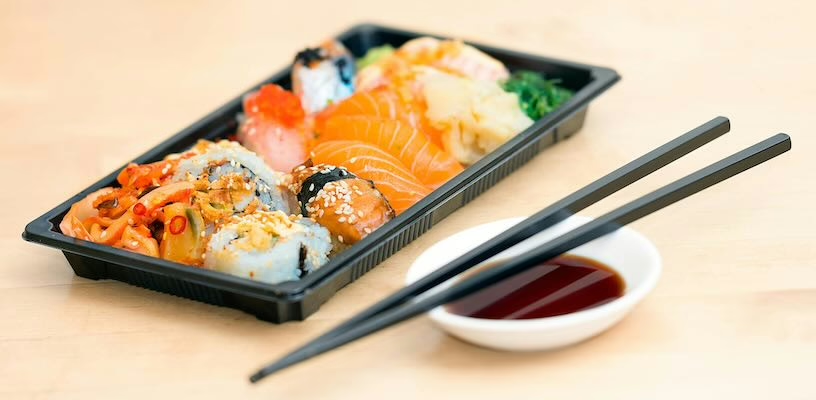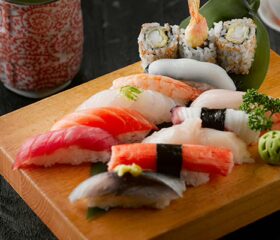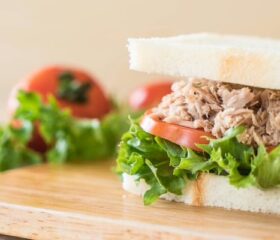Can You Eat Sushi While Pregnant?
Do you have a craving for sushi? If you’re pregnant, you may want to pump the brakes before reaching for that California roll or piece of sashimi.

Raw fish is, unfortunately, a no-go during pregnancy. However, while raw or undercooked fish is on the list of foods to avoid during pregnancy, that doesn’t mean you have to skip sushi nights with your partner, family, or friends. You’ll just have to be a little careful.
Here’s everything you need to know about eating sushi while you’re pregnant.
Can you eat sushi when you’re pregnant?
The answer isn’t a straight “yes” or “no” as sushi can be prepared differently.
You’ll need to avoid raw fish, along with other kinds of undercooked seafood or meat. That means nigiri (if made with raw fish) and sashimi—along with raw clams, oysters, and scallops—are off the table when you’re pregnant. 1
Watch out for seared fish, too
You should also watch out for seared fish like tuna and salmon, as they’re usually cooked superficially. This means they’ll be cooked or crusted on the outer edges, but remain raw on the inside. You’ll need to avoid superficially seared fish until you’re no longer pregnant. 2
Why raw fish is dangerous during pregnancy
When food is raw or undercooked, there’s a high risk that it’s contaminated with bacteria. Your immune system changes during pregnancy, making you extra susceptible to the harms of bacteria like listeria.
Listeria monocytogenes is a type of bacteria that grows due to unsanitary food preparation and storage practices. It’s often found in refrigerated meat, seafood, dairy, and unpasteurized goods.
While listeria infections (listeriosis) are normally quite rare, you’re 10 times more likely to get them when you’re pregnant. 3
What are the symptoms of listeriosis?
Listeriosis symptoms during pregnancy can resemble those of a cold or the flu, and they can take up to two months to show up. 4 It’s also possible you won’t have any symptoms at all, but the disease could still harm your growing baby.
If you don’t get listeriosis treated, it could lead to problems for your baby like preterm labor, low birth weight, miscarriage, or stillbirth.
Can you eat cooked sushi?
Not all sushi is served raw, and it’s fine to eat cooked seafood while you’re pregnant, so long as you opt for fish that’s low in mercury. (More on this below.)
You have plenty of options to choose from. Cooked salmon and California rolls, tempura rolls, eel rolls, and chicken teriyaki or katsu rolls are all safe to eat.
When dining out, many sushi restaurants will have sections devoted to raw sushi and cooked sushi, which will help you narrow down your choices and focus on the ones you can safely enjoy. 5
What to do if you’ve eaten raw sushi
Eating raw sushi doesn’t guarantee you’ll get listeriosis, but it does increase your chances of getting sick. If you’ve eaten raw sushi or undercooked seafood, watch your body for signs of illness, like stomach pains, vomiting, fever, chills, and nausea.
However, you should call or make an appointment with your doctor even if you feel fine, since it can take a while for the symptoms to show up (if they ever do). The earlier your doctor catches listeriosis, the easier it’ll be to manage.
Should you avoid sushi and seafood completely during pregnancy?
Despite the fears around listeria, properly cooked fish and seafood are actually great additions to a healthy pregnancy diet.
The Food and Drug Administration (FDA) recommends that women have between 8 and 12 ounces of seafood each week during pregnancy. This can improve your heart and bone health and help you manage your weight, and it contains a whole host of nutrients that will help develop your baby’s brain, spine, and immune system. 6 7
Nutritional benefits of (safe) seafood
Many kinds of fish are high in omega-3 or omega-6 fatty acids. They can also be a great source of: 7
- Iron
- Iodine
- Choline
- Zinc
- Vitamin B12
- Vitamin D
- Selenium
Eating fish while you’re pregnant may even improve your baby’s heart and cognitive development. 1
How to safely enjoy fish and seafood during pregnancy
Rather than ditching seafood and sushi altogether, here are tips for how to safely enjoy them:
Eat low-mercury seafood
Whether you’re eating sushi, sashimi, or another dish, choose dishes that contain low-mercury seafood varieties.
For example, while pregnant women can eat some canned tuna, bigeye tuna is a notable offender for its high mercury content. You should also watch out for: 7
- King mackerel
- Marlin
- Orange roughy
- Shark
- Swordfish
- Tilefish
As a rough guideline, the bigger a fish gets and the higher on the food chain it is, the more mercury tends to accumulate in its body.
If you eat too much mercury, the exposure can damage your brain and nervous system and cause birth defects in your baby. It’s a good idea to take high-mercury fish off your menu until your pregnancy is over. 5 6
Be careful with refrigerated, frozen, or premade seafood
Refrigerated fish like lox, nova, or smoked salmon can be contaminated by bacteria. The same goes for frozen seafood like shrimp. Similarly, pregnant women can’t eat ceviche or seafood salads.
With all that said, you can bake pre-packaged seafood until they reach a safe internal temperature of 165℉, killing any bacteria they harbor.
Smoked seafood that’s been cooked and canned or stored in other types of shelf-stable packaging is fine to consume. 1
Try other items at the sushi restaurant
As mentioned, not everything at your favorite sushi joint contains raw fish. You can opt for vegetarian rolls, sautéed vegetables, cooked rice dishes, miso soup, or dishes made with meat alternatives like tofu or tempeh.
Sushi restaurants usually also offer teriyaki entrees. However, while pregnant women can eat shrimp, chicken, steak, and salmon, if you order them, make sure that the meat is fully cooked.
Watch out for buffets
Bacteria love warmth. The longer that food sits out, the greater the chances are that it’ll develop bacteria. Whether you’re eating at a seafood buffet or you’re at a cookout or picnic, be careful about what you eat.
This doesn’t mean you have to turn down that tasty lobster tail your father-in-law just cooked for you on the grill. If it came directly off the stove, from the fridge, or out of a shelf-stable container, you’ll be okay. 8
On that note, keep an eye on how long everything has sat out. Generally, 2 hours at room temperature is the longest food should be out before it gets tossed. If you’re outside on a hot day (over 90°F), you’ll have to throw it out after an hour. 9
Use soy sauce sparingly
When you’re pregnant, you have to be careful about how much sodium you consume.
While it won’t put you at risk of foodborne illnesses, too much sodium can be bad for your health and the health of your baby. A single tablespoon of soy sauce, for instance, can have as much as 1,180 mg of sodium in it. The USDA recommends that pregnant women limit their daily intake to 2,300 mg. 10
Prioritize cleanliness
When you prepare seafood at home, practice good sanitation. Keep raw and cooked foods separate. Fully clean every surface, dish, cutting board, utensils, or cooking implements. Also, wash your hands in warm water with soap after handling raw seafood.
You should also make sure that any sushi restaurants you visit follow good hygiene practices. It’s a good idea to let them know that you’re pregnant so that they can limit the risk of cross-contamination.
Final thoughts
If the idea of saying sayonara to sushi makes you shed a tear, then you’ll be glad to know that you can still eat some kinds while you’re pregnant. As long as you stick to cooked seafood low in mercury and let the restaurant know that you’re avoiding raw fish, then you can enjoy it to your heart’s content.
Article Sources
- FoodSafety.gov. "People at Risk: Pregnant Women" Retrieved September 5, 2025.
- Cleveland Clinic. "Foods To Avoid During Pregnancy" Retrieved September 5, 2025.
- U.S. Food and Drug Administration. "Listeria (Food Safety for Moms-to-Be)" Retrieved September 5, 2025.
- American College of Obstetricians and Gynecologists. "Listeria and Pregnancy" Retrieved September 5, 2025.
- American Pregnancy Association. "Is Sushi Safe for Pregnant Women?" Retrieved September 5, 2025.
- U.S. Food and Drug Administration. "Questions & Answers from the FDA/EPA Advice about Eating Fish for Those Who Might Become or Are Pregnant or Breastfeeding and Children Ages 1 to 11 Years" Retrieved September 5, 2025.
- U.S. Food and Drug Administration. "Advice about Eating Fish" Retrieved September 5, 2025.
- U.S. Food and Drug Administration. "Ready-to-Eat Foods (Food Safety for Moms-to-Be)" Retrieved September 5, 2025.
- U.S. Food and Drug Administration. "Eating Out & Bringing In (Food Safety for Moms-to-Be)" Retrieved September 5, 2025.
- United States Department of Veterans Affairs. "Prenatal Nutrition Goals" Retrieved September 5, 2025.







